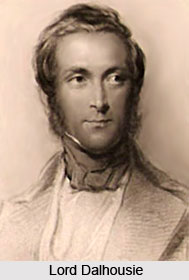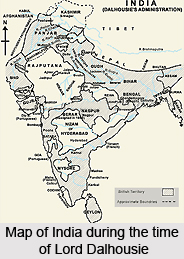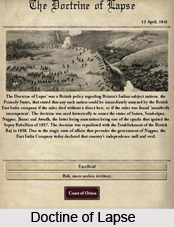 Lord Dalhousie was appointed Governor General of India in 1848. His eight years of rule is considered one of the greatest periods of British rule in India. His policy of Annexation was a lethal weapon of conquest, which raised the rule of the East India Company to the height of glory. It was also during his rule that various reforms were brought to improve the conditions of India. Though these directly benefited the British yet they were foundations on which the country built itself after independence. Dalhousie becoming the governor General of India adopted the reforms in almost all fields.
Lord Dalhousie was appointed Governor General of India in 1848. His eight years of rule is considered one of the greatest periods of British rule in India. His policy of Annexation was a lethal weapon of conquest, which raised the rule of the East India Company to the height of glory. It was also during his rule that various reforms were brought to improve the conditions of India. Though these directly benefited the British yet they were foundations on which the country built itself after independence. Dalhousie becoming the governor General of India adopted the reforms in almost all fields.
The administrative reforms introduced by Dalhousie included almost all the departments of administration. Lord Dalhousie was a true administrator and a great imperialist. Being a governor general he took care to consolidate the gains of the Company. To relieve the governor general to perform his wider responsibilities, the Bengal presidency was kept under the charge of the Lieutenant Governor. This Lieutenant Governor was responsible to the Governor General directly. For the newly acquired territories Lord Dalhousie introduced a system of centralized control. This was known as the "Non Regulation" System. According to this system of Non Regulation, Dalhousie appointed a new Commissioner over a newly acquired territory. This Commissioner was directly responsible to the Governor General proper i.e. Lord Dalhousie.
As a governor general, Dalhousie wanted to extend the authority of the Company. With his policy of annexation, Dalhousie had extended the British authority from Bengal in the east to the Punjab and Sind in the west. Lord Dalhousie adopted several military reforms in order to materialize his aim of extending Company`s authority in the major parts of India. According to the military reforms adopted by him, first of all the headquarter of the Bengal Artillery was shifted from Calcutta to Meerut. The permanent headquarter of the army was shifted to Simla and the process was completed in 1865. During the second Anglo Sikh war Dalhousie foresaw the danger in the great numerical increase of the Indian Army. He proposed reduction of the strength of the Indian Element in the army. He intimidated the Home authorities in England the necessity increasing the strength of the European soldier in India. He reformed the military system and wanted to maintain equipoise between the British and the Indian troops. He declared that the British force in India as the essential element of the strength. Under theses reforms, three regiments were added to the army. Moreover he protested against the dispatch of two European regiments for services to China and Persia. A new "Irregular Force" was created in Punjab under the direct control of the Punjab administration. Gorkha regiments were raised and to improve their strength continuous measures were adopted. This Gorkha Regiments proved invaluable to the British during the revolt of 1857.
Lord Dalhousie introduced a number of educational reforms. In 1853, the Thomasonian system of vernacular education was recommended for the whole of the Northwestern provinces, Lower Bengal and Punjab with some modifications. Similar instructions were also sent to the Bombay and the Madras authorities. In July 1854 Charles Wood, the President of the Board of Control addressed to the Government of India his famous education dispatch, known as "Woods dispatch". According to the Woods Dispatch there would be a properly articulated scheme of education from primary schools to the university. Wood`s Dispatch was very comprehensive. It laid the foundation on which modern education system had been built up. It recommended the Anglo-vernacular school throughout the districts. Government Colleges of important towns and Universities in each of the three Presidencies in India. The infiltration theory was abandoned. Voluntary efforts in the field of education were to be aided by the grants in aid policies of the state. Such grants-in-aid were subjected to several rules and the conditions. A Director of Public Instruction was to be appointed in each province that would be aided by inspectors.  By this measure the government can control and organize the education system from the lower level to the University. Several universities of English model were set up in Calcutta. These universities were intended for giving award degrees as a token on the acquirement of Knowledge,. Teaching of both vernacular and English was to be encouraged. But the English preferred the western medium of education, Western philosophy and sciences. An Engineering college was also established at Rookee under these educational reforms.
By this measure the government can control and organize the education system from the lower level to the University. Several universities of English model were set up in Calcutta. These universities were intended for giving award degrees as a token on the acquirement of Knowledge,. Teaching of both vernacular and English was to be encouraged. But the English preferred the western medium of education, Western philosophy and sciences. An Engineering college was also established at Rookee under these educational reforms.
Under Dalhousie the communication and transport was developed exceptionally. Dalhousie introduced strategic railway lines in order to facilitate the internal communication for the defence of India. Lord Dalhousie laid down the broad outlines of the schemes in his famous Railway Minute of 1853, which formed the basis for the future railway extension in India. The foundation of the first railway line connecting Bombay with Thane was laid down in 1853. In the following year, a railway line was built from Calcutta to the Raniganj Coalfields. A few miles of railway lines were also built in the Madras Presidency. Within a short period various routes were being surveyed and the railway lines were constructed there. However Dalhousie did not cost the construction of the Rail lines on the Indians exchequer. Rather it was built out by the private enterprises. Since in the construction of the Railway lines the English Capital were invested subsequently railway lines in India were passed under the system of "Government guarantee". Therefore the railway lines in India became the monopoly of the English. Whatever the effect is the railways in India encourage the trade and commerce and strengthened the British military set up.
Dalhousie was regarded as the Father of the Electric telegraph in India. He introduced the Electric Telegraph system, which accentuated the communication system in India. He appointed O` Shanhnessy as the Superintendent of the Electric telegraph department. In due course nearly 4000 miles of electric telegraph lines were constructed connecting Calcutta with Peshwar, Bombay and Madras and other parts of the country. In Burma a line was laid down from Rangoon to Mandalay. The Telegraph Department proved of great assistance during the great Rebellion of 1857-58.
The basis of the modern postal also system also laid down under Lord Dalhousie. As a result of the findings of an expert commission, by new post office Act was passed in 1854. Under the new system a Director-General was appointed to superintend the work of Post Office in all the Presidencies; a uniform rate of half an anna per letter, irrespective of the distance over which it might be sent, was introduced, postage stamp was issued for the first time. As a result of these reforms the Post office, which had so far been a drain on the treasury became a source of revenue. The social, administrative, financial and the educational developments resulted from the extension and improvement of the Postal system. Thus Dalhousie worked for the promotion of the material progress in India.
 Before Dalhousie the construction of the Public Works had been a part of the job of the military board. A separate Public works department was set up for the first time. A large amount of funds began to be spent on the works of the public utility. Irrigational works were undertaken on an extensive scale. The main stream of the Ganges canal was completed and declared open on 8th April 1854. Moreover the construction work was connected with the Bari Doab Canal in the Punjab was initiated under the supervision of Lord Dalhousie. In the subsequent years many bridges were constructed and the work on the Grand Trunk road was taken up with more enthusiasm.
Before Dalhousie the construction of the Public Works had been a part of the job of the military board. A separate Public works department was set up for the first time. A large amount of funds began to be spent on the works of the public utility. Irrigational works were undertaken on an extensive scale. The main stream of the Ganges canal was completed and declared open on 8th April 1854. Moreover the construction work was connected with the Bari Doab Canal in the Punjab was initiated under the supervision of Lord Dalhousie. In the subsequent years many bridges were constructed and the work on the Grand Trunk road was taken up with more enthusiasm.
Through the commercial reforms introduced by Lord Dalhousie, the ports of India were made free to the commerce with all over the world. Free trade became the order of the day and the harbors of Bombay, Karachi, and Calcutta etc were developed in large number. Several lighthouses were also constructed along these ports. In the commercial reforms of Dalhousie Agriculture got special attention. The digging of canals, the development of Railway facilities and the construction of works of the public utility was introduced a new commercial era. Indian resources particularly the of cotton, flax and tea were grown highly. These agricultural products sufficed the need of the raw materials for the mills of Lancashire and Manchester. In return cheap manufactured goods from England were imported in plenty. In this way the Indian trade became the complete monopoly of the British East India Company. The commercial reforms, which had been undertaken by Dalhousie, were primarily aimed to improve the commercial condition of the east India Company. Hence Dalhousie concentrated the trade and commerce completely within the East India Company, so that the Company could maintain its monopoly and overcame the financial crisis.
Apart from the administrative educational and the commercial reforms, lord Dalhousie introduced the policy of Doctrine of Lapse. The Doctrine of lapse was considered as one of his important political reforms by which he extended the English authority by a policy of annexation. Through this policy the sovereignty of independent states was lapsed to British Indian government when such a state lacked a natural heir and right of adoption was declared invalid. By this measure Dalhousie annexed the states of Satara, Sambalpur, Udaipur, Jhansi and Nagpur. Dalhousie abolished the so-called sovereignties of the Carnatic and Tanjore as he regarded them obsolete and refused, on the death of the ex-Peshwa Baji Rao II. Dalhousie refused the allowance of Nana Sahib, since he was the adopted heir of the Peshwa. In the end he also annexed Oudh in 1856 on the ground of misgovernment. He wished to abolish the imperial title of the Mughal emperor and withdraw the royal family from the palace in Delhi and deprive Bahadur Shah`s son of the imperial name. Dalhousie thus brought the major section of India under his own control. However the Doctrine of Lapse was considered as the immediate cause of the revolt of 1857-58.



















